Biochar Amendment Enhances Water Retention in a Tropical Sandy Soil
Abstract
1. Introduction
2. Materials and Methods
2.1. Soil and Biochar Characteristics
2.2. Experimental Design
2.3. Soil Physical Sampling and Analyses
2.3.1. Soil Water Retention Curve (SWRC)
2.3.2. Plant-Available Water Content and Soil Porosity
2.3.3. Soil Water (SWSC) and Air (SAC) Storage Capacity Indexes
2.4. Data Analysis
3. Results
3.1. Soil Bulk Density
3.2. Soil Water Retention Curves (SWRCs) and Available Water Content (AWC)
3.3. Pore Size Distribution
3.4. Soil Water Storage Capacity (SWSC) and Soil Air Capacity (SAC) Indexes
4. Discussion
5. Conclusions
Author Contributions
Funding
Acknowledgments
Conflicts of Interest
References
- Paustian, K.; Lehmann, J.; Ogle, S.; Reay, D.; Robertson, G.; Smith, P. Climate-smart soils. Nature 2016, 532, 49–57. [Google Scholar] [CrossRef] [PubMed]
- Bai, X.; Huang, Y.; Ren, W.; Coyne, M.; Jacinthe, P.A.; Tao, B.; Matocha, C. Responses of soil carbon sequestration to climate-smart agriculture practices: A meta-analysis. Glob. Chang. Biol. 2019, 25, 2591–2606. [Google Scholar] [CrossRef] [PubMed]
- Smith, P.; Martino, D.; Cai, Z.C.; Gwary, D.; Janzen, H.; Kumar, P.; McCarl, B.; Ogle, S.; O’Mara, F.; Rice, C.; et al. Policy and technological constraints to implementation of greenhouse gas mitigation options in agriculture. Agric. Ecosyst. Environ. 2007, 118, 6–28. [Google Scholar] [CrossRef]
- Tubiello, F. Agriculture, Forestry and Other Land Use Emissions by Sources and Removals by Sinks: 1990–2011 Analysis; FAO Statistics Division: Rome, Italy, 2014. [Google Scholar]
- Vörösmarty, C.J.; Sahagian, D. Anthropogenic disturbance of the terrestrial water cycle. Bioscience 2000, 50, 753–765. [Google Scholar] [CrossRef]
- Trenberth, K.E.; Fasullo, J.T.; Shepherd, T.G. Attribution of climate extreme events. Nat. Clim. Chang. 2015, 5, 725–730. [Google Scholar] [CrossRef]
- Christofidis, D. Irrigação, a fronteira hídrica na produção de alimentos. Irrigação e Tecnologia Moderna 2002, 54, 46–55. [Google Scholar]
- Sentelhas, P.C.; Battisti, R.; Camara, G.M.S.; Farias, J.R.B.; Hampf, A.C.; Nendel, C. The soybean yield gap in Brazil—Magnitude, causes and possible solutions for sustainable production. J. Agric. Sci. 2015, 153, 1394–1411. [Google Scholar] [CrossRef]
- Dias, H.B.; Sentelhas, P.C. Sugarcane yield gap analysis in Brazil—A multi-model approach for determining magnitudes and causes. Sci. Total Environ. 2018, 637, 1127–1136. [Google Scholar] [CrossRef]
- Lal, R.; Negassa, W.; Lorenz, K. Carbon sequestration in soil. Curr. Opin. Environ. Sustain. 2015, 15, 79–86. [Google Scholar] [CrossRef]
- Lone, A.H.; Najar, G.R.; Ganie, M.A.; Sofi, J.A.; Ali, T. Biochar for Sustainable Soil Health: A Review of Prospects and Concerns. Pedosphere 2015, 25, 639–653. [Google Scholar] [CrossRef]
- Ding, Y.; Liu, Y.G.; Liu, S.B.; Huang, X.X.; Li, Z.W.; Tan, X.F.; Zeng, G.M.; Zhou, L. Potential Benefits of Biochar in Agricultural Soils: A Review. Pedosphere 2017, 27, 645–661. [Google Scholar] [CrossRef]
- Chibuike, G.; Uzoh, I.; Unagwu, B. Biochar-induced modification of soil properties and the effect on crop production. Adv. Agric. Sci. 2019, 7, 59–87. [Google Scholar]
- Deluca, T.H.; Gundale, M.J.; MacKenzie, M.D.; Jones, D.L. Biochar effects on soil nutrient transformations. In Biochar for Environmental Management: Science, Technology and Implementation, 2nd ed.; Lehmann, J., Joseph, S., Eds.; Earthscan: New York, NY, USA, 2015; pp. 424–425. [Google Scholar]
- Gul, S.; Whalen, J.K. Biochemical cycling of nitrogen and phosphorus in biochar-amended soils. Soil Biol. Biochem. 2016, 103, 1–15. [Google Scholar] [CrossRef]
- Jin, Y.; Liang, X.Q.; He, M.M.; Liu, Y.; Tian, G.M.; Shi, J.Y. Manure biochar influence upon soil properties, phosphorus distribution and phosphatase activities: A microcosm incubation study. Chemosphere 2016, 142, 128–135. [Google Scholar] [CrossRef] [PubMed]
- Novais, S.V.; Zenero, M.D.O.; Barreto, M.S.C.; Montes, C.R.; Cerri, C.E.P. Phosphorus removal from eutrophic water using modified biochar. Sci. Total Environ. 2018, 63, 825–835. [Google Scholar] [CrossRef] [PubMed]
- Lehmann, J.; Rillig, M.C.; Thies, J.; Masiello, C.A.; Hockaday, W.C.; Crowley, D. Biochar effects on soil biota—A review. Soil Biol. Biochem. 2011, 43, 1812–1836. [Google Scholar] [CrossRef]
- Razzaghi, F.; Obour, P.B.; Arthur, E. Does biochar improve soil water retention? A systematic review and meta-analysis. Geoderma 2020, 361, 114055. [Google Scholar] [CrossRef]
- Abel, S.; Peters, A.; Trinks, S.; Schonsky, H.; Facklam, M.; Wessolek, G. Impact of biochar and hydrochar addition on water retention and water repellency of sandy soil. Geoderma 2013, 202, 183–191. [Google Scholar] [CrossRef]
- Liu, Z.L.; Dugan, B.; Masiello, C.A.; Gonnermann, H.M. Biochar particle size, shape, and porosity act together to influence soil water properties. PLoS ONE 2017, 12, e0179079. [Google Scholar] [CrossRef]
- Wang, D.Y.; Li, C.Y.; Parikh, S.J.; Scow, K.M. Impact of biochar on water retention of two agricultural soils —A multi-scale analysis. Geoderma 2019, 340, 185–191. [Google Scholar] [CrossRef]
- Carvalho, M.T.D.; Maia, A.D.N.; Madari, B.E.; Bastiaans, L.; van Oort, P.A.J.; Heinemann, A.B.; da Silva, M.A.S.; Petter, F.A.; Marimon, B.H.; Meinke, H. Biochar increases plant-available water in a sandy loam soil under an aerobic rice crop system. Solid Earth 2014, 5, 939–952. [Google Scholar] [CrossRef]
- Obia, A.; Mulder, J.; Martinsen, V.; Cornelissen, G.; Borresen, T. In situ effects of biochar on aggregation, water retention and porosity in light-textured tropical soils. Soil Till. Res. 2016, 155, 35–44. [Google Scholar] [CrossRef]
- Tanure, M.M.C.; da Costa, L.M.; Huiz, H.A.; Fernandes, R.B.A.; Cecon, P.R.; Pereira, J.D.; da Luz, J.M.R. Soil water retention, physiological characteristics, and growth of maize plants in response to biochar application to soil. Soil Till. Res. 2019, 192, 164–173. [Google Scholar] [CrossRef]
- Santos, H.G.; Jacomine, P.; dos Anjos, L.H.C.; de Oliveira, V.A.; Lumbreras, J.F.; Coelho, M.R.; de Almeida, J.A.; de Araujo Filho, J.C.; de Oliveira, J.B.; Cunha, T.J.F. Brazilian Soil Classification System, 5th ed.; Reichart, C.E.A.; Anjos, L.H.C.; dos Alves, M.C.; dos Santos, H.G.; Lumbreras, J.F., Translators; rev. and exp. Embrapa soil (CNPS): Brasília, Brazil, 2018; ISBN 978-85-7035-821-9. [Google Scholar]
- Rittl, T.F.; Butterbach-Bahl, K.; Basile, C.M.; Pereira, L.A.; Alms, V.; Dannenmann, M.; Couto, E.G.; Cerri, C.E.P. Greenhouse gas emissions from soil amended with agricultural residue biochars: Effects of feedstock type, production temperature and soil moisture. Biomass Bioenerg. 2018, 117, 1–9. [Google Scholar] [CrossRef]
- Woolf, D.; Amonette, J.; Street-Perrott, F.; Lehmann, J.; Joseph, S. Sustainable biochar to mitigate global climate change. Nat. Commun. 2010, 1. [Google Scholar] [CrossRef] [PubMed]
- Kirkham, M.B. Field Capacity, Wilting Point, Available Water, and the Non-Limiting Water Range. In Principles of Soil and Plant Water Relations; Kirkham, M.B., Ed.; Academic Press: Cambridge, MA, USA, 2005; pp. 101–115. [Google Scholar] [CrossRef]
- Dane, J.H.; Topp, C. Physical Methods. In Methods of Soil Analysis; Soil Science Society of America Book Series, no. 5; Soil Science Society of America Inc.: Madison, WI, USA, 2002; p. 1962. [Google Scholar]
- Dourado-Neto, D.; Nielsen, D.R.; Hopmans, J.W.; Reichardt, K.; Bacchi, O.O.S. Software to model soil water retention curves (SWRC, version 2.00). Sci. Agric. 2000, 57, 191–192. [Google Scholar] [CrossRef]
- Van Genuchten, M.T. A Closed-Form Equation for Predicting the Hydraulic Conductivity of Unsaturated Soils. Soil Sci. Soc. Am. J. 1980, 44, 892–898. [Google Scholar] [CrossRef]
- Mualem, Y. A new model for predicting the hydraulic conductivity of unsaturated porous media. Water Resour. Res. 1976, 12, 513–522. [Google Scholar] [CrossRef]
- Marsall, T.J.; Holmes, J.W. Soil Physics; Cambridge Univ. Press: New York, NY, USA, 1988. [Google Scholar]
- Reynolds, W.D.; Bowman, B.T.; Drury, C.F.; Tan, C.S.; Lu, X. Indicators of good soil physical quality: Density and storage parameters. Geoderma 2002, 110, 131–146. [Google Scholar] [CrossRef]
- Mukherjee, A.; Lal, R. Biochar Impacts on Soil Physical Properties and Greenhouse Gas Emissions. Agronomy 2013, 2, 313–339. [Google Scholar] [CrossRef]
- Lim, T.J.; Spokas, K.A.; Feyereisen, G.; Novak, J.M. Predicting the impact of biochar additions on soil hydraulic properties. Chemosphere 2016, 142, 136–144. [Google Scholar] [CrossRef] [PubMed]
- Verheijen, F.G.A.; Zhuravel, A.; Silva, F.C.; Amaro, A.; Ben-Hur, M.; Keizer, J.J. The influence of biochar particle size and concentration on bulk density and maximum water holding capacity of sandy vs sandy loam soil in a column experiment. Geoderma 2019, 347, 194–202. [Google Scholar] [CrossRef]
- Duarte, S.D.; Glaser, B.; Cerri, C.E.P. Effect of Biochar Particle Size on Physical, Hydrological and Chemical Properties of Loamy and Sandy Tropical Soils. Agronomy 2019, 9, 165. [Google Scholar] [CrossRef]
- Glaser, B.; Lehmann, J.; Zech, W. Ameliorating physical and chemical properties of highly weathered soils in the tropics with charcoal—A review. Biol. Fertil. Soils 2002, 35, 219–230. [Google Scholar] [CrossRef]
- Moraes, M.T.; Debiasi, H.; Carlesso, R.; Franchini, J.C.; Silva, V.R.; Luz, F.B. Age-hardening phenomena in an oxisol from the subtropical region of Brazil. Soil Till. Res. 2017, 170, 27–37. [Google Scholar] [CrossRef]
- Reichert, J.M.; Rosa, V.T.; Vogelmann, E.S.; Rosa, D.P.; Horn, R.; Reinert, D.J.; Sattler, A.; Denardin, J.E. Conceptual framework for capacity and intensity physical soil properties affected by short and long-term (14 years) continuous no-tillage and controlled traffic. Soil Till. Res. 2016, 158, 123–136. [Google Scholar] [CrossRef]
- Bonetti, J.A.; Anghinoni, I.; Moraes, M.T.; Fink, J.R. Resilience of soils with different texture, mineralogy and organic matter under long-term conservation systems. Soil Till. Res. 2017, 174, 104–112. [Google Scholar] [CrossRef]
- Dexter, A.R.; Horn, R.; Kemper, W.D. Two mechanisms for age-hardening of soil. J. Soil Sci. 1988, 39, 163–175. [Google Scholar] [CrossRef]
- Horn, R. Time dependence of soil mechanical properties and pore functions for arable soils. Soil Sci. Soc. Am. J. 2004, 68, 1131–1137. [Google Scholar] [CrossRef]
- Downie, A.; Munroe, P.; Crosky, A. Characteristics of Biochar—Physical and Structural Properties. In Biochar for Environmental Management: Science and Technology, 1st ed.; Lehmann, J., Joseph, S., Eds.; Earthscan: New York, NY, USA, 2009; pp. 13–29. [Google Scholar]
- Herath, H.M.S.K.; Camps-Arbestain, M.; Hedley, M. Effect of biochar on soil physical properties in two contrasting soils: An Alfisol and an Andisol. Geoderma 2013, 209–210, 188–197. [Google Scholar] [CrossRef]
- Ulyett, J.; Sakrabani, R.; Kibblewhite, M.; Hann, M. Impact of biochar addition on water retention, nitrification and carbon dioxide evolution from two sandy loam soils. Eur. J. Soil Sci. 2014, 65, 96–104. [Google Scholar] [CrossRef]
- Hardie, M.; Clothier, B.; Bound, S.; Oliver, G.; Close, D. Does biochar influence soil physical properties and soil water availability? Plant Soil 2014, 376, 347–361. [Google Scholar] [CrossRef]
- Barnes, R.T.; Gallagher, M.E.; Masiello, C.A.; Liu, Z.L.; Dugan, B. Biochar-Induced Changes in Soil Hydraulic Conductivity and Dissolved Nutrient Fluxes Constrained by Laboratory Experiments. PLoS ONE 2014, 9, e108340. [Google Scholar] [CrossRef] [PubMed]
- Petersen, C.T.; Hansen, E.; Larsen, H.H.; Hansen, L.V.; Ahrenfeldt, J.; Hauggaard-Nielsen, H. Pore-size distribution and compressibility of coarse sandy subsoil with added biochar. Eur. J. Soil Sci. 2016, 67, 726–736. [Google Scholar] [CrossRef]
- Peake, L.R.; Reid, B.J.; Tang, X.Y. Quantifying the influence of biochar on the physical and hydrological properties of dissimilar soils. Geoderma 2014, 235, 182–190. [Google Scholar] [CrossRef]
- Jeffery, S.; Meinders, M.B.J.; Stoof, C.R.; Bezemer, T.M.; van de Voorde, T.F.J.; Mommer, L.; van Groenigen, J.W. Biochar application does not improve the soil hydrological function of a sandy soil. Geoderma 2015, 251, 47–54. [Google Scholar] [CrossRef]
- Ajayi, A.E.; Holthusen, D.; Horn, R. Changes in microstructural behaviour and hydraulic functions of biochar amended soils. Soil Till. Res. 2016, 155, 166–175. [Google Scholar] [CrossRef]
- Kinney, T.J.; Masiello, C.A.; Dugan, B.; Hockaday, W.C.; Dean, M.R.; Zygourakis, K.; Barnes, R.T. Hydrologic properties of biochars produced at different temperatures. Biomass Bioenerg. 2012, 41, 34–43. [Google Scholar] [CrossRef]
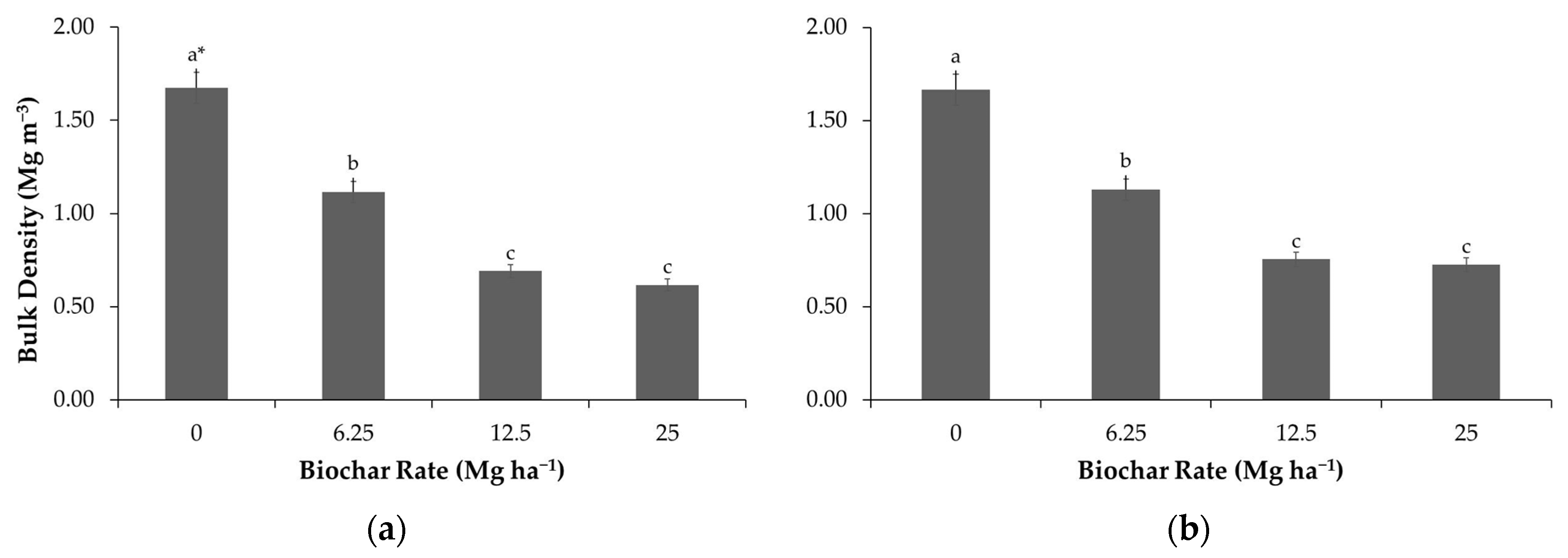
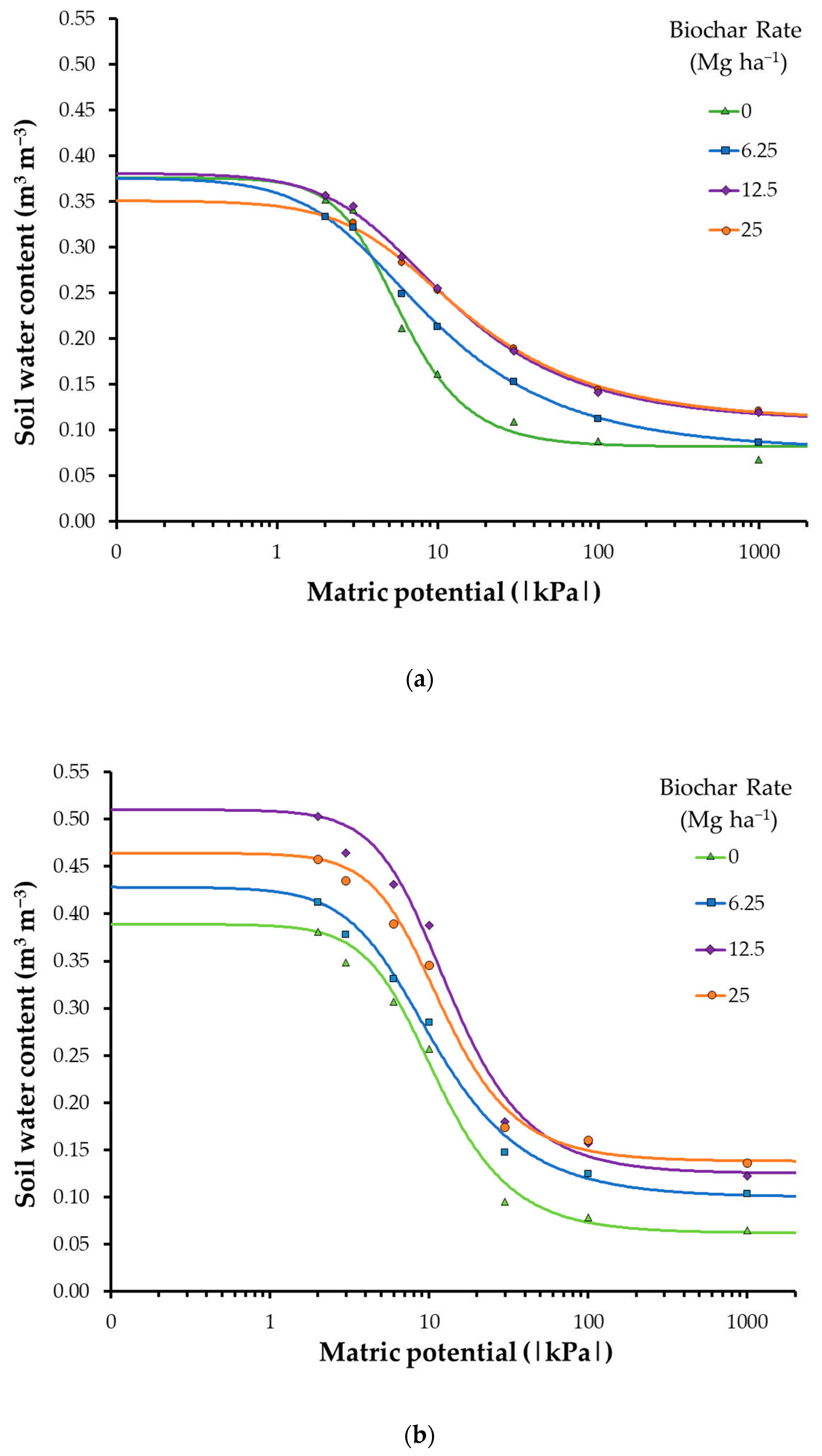
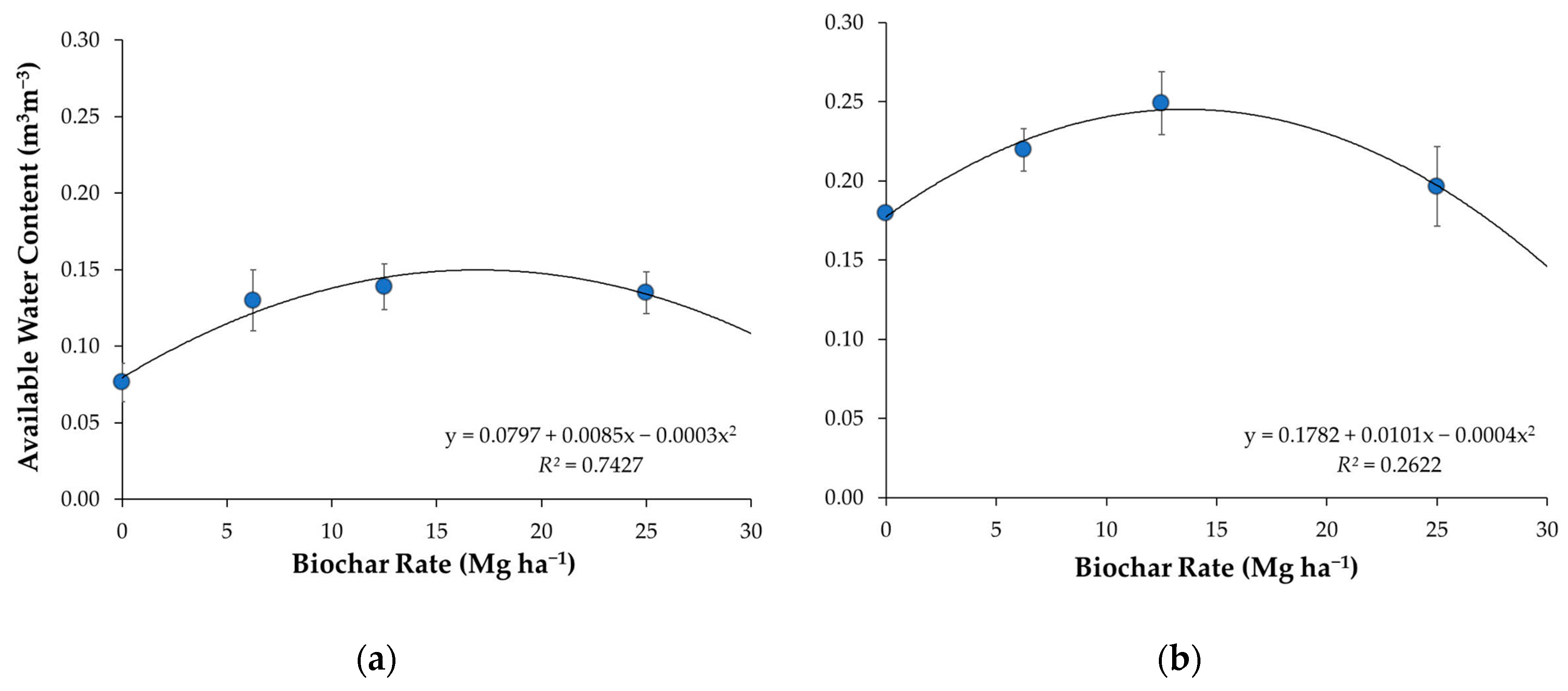
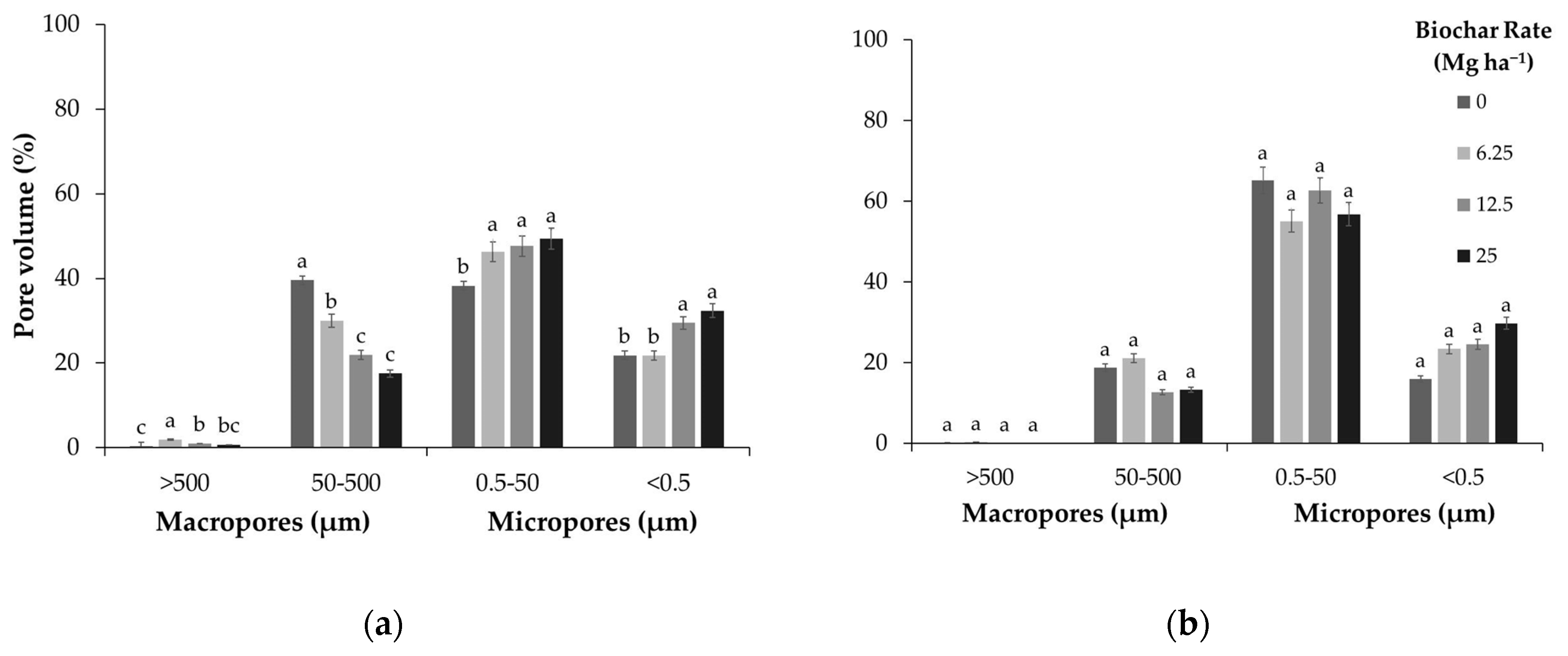
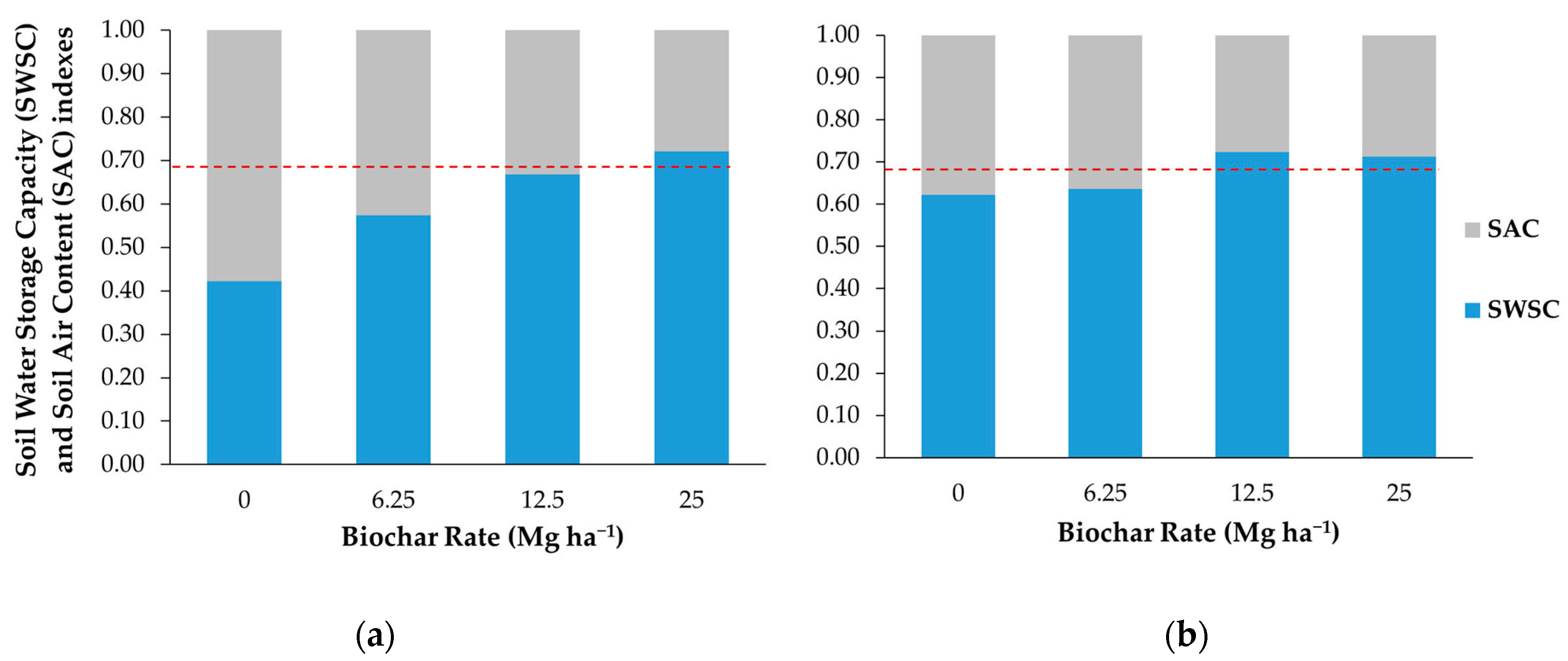
| Feedstock | Pyrolysis Temperature (°C) | Surface Area (m2 g−1) | C | N | C:N | pH | Cation Exchange Capacity |
|---|---|---|---|---|---|---|---|
| % | |||||||
| Miscanthus giganteus | 450 | 371.9 | 64.4 | 0.8 | 78.4 | 5.9 | 20.1 |
| Biochar Rate (Mg ha−1) | SWRC Parameters | |||||
|---|---|---|---|---|---|---|
| α | m | n | θr | θs | r2 | |
| kPa−1 | m3 m−3 | |||||
| 50 days after biochar incorporation | ||||||
| 0 | 0.233 | 0.601 | 2.505 | 0.082 | 0.376 | 0.988 |
| 6.25 | 0.324 | 0.381 | 1.615 | 0.079 | 0.376 | 0.996 |
| 12.5 | 0.230 | 0.393 | 1.649 | 0.110 | 0.381 | 0.998 |
| 25 | 0.191 | 0.387 | 1.630 | 0.111 | 0.351 | 0.998 |
| 150 days after biochar incorporation | ||||||
| 0 | 0.131 | 0.568 | 2.314 | 0.062 | 0.389 | 0.991 |
| 6.25 | 0.161 | 0.503 | 2.013 | 0.100 | 0.428 | 0.993 |
| 12.5 | 0.111 | 0.559 | 2.266 | 0.125 | 0.510 | 0.988 |
| 25 | 0.119 | 0.576 | 2.357 | 0.138 | 0.464 | 0.992 |
© 2020 by the authors. Licensee MDPI, Basel, Switzerland. This article is an open access article distributed under the terms and conditions of the Creative Commons Attribution (CC BY) license (http://creativecommons.org/licenses/by/4.0/).
Share and Cite
Lustosa Carvalho, M.; Tuzzin de Moraes, M.; Cerri, C.E.P.; Cherubin, M.R. Biochar Amendment Enhances Water Retention in a Tropical Sandy Soil. Agriculture 2020, 10, 62. https://doi.org/10.3390/agriculture10030062
Lustosa Carvalho M, Tuzzin de Moraes M, Cerri CEP, Cherubin MR. Biochar Amendment Enhances Water Retention in a Tropical Sandy Soil. Agriculture. 2020; 10(3):62. https://doi.org/10.3390/agriculture10030062
Chicago/Turabian StyleLustosa Carvalho, Martha, Moacir Tuzzin de Moraes, Carlos Eduardo P. Cerri, and Maurício Roberto Cherubin. 2020. "Biochar Amendment Enhances Water Retention in a Tropical Sandy Soil" Agriculture 10, no. 3: 62. https://doi.org/10.3390/agriculture10030062
APA StyleLustosa Carvalho, M., Tuzzin de Moraes, M., Cerri, C. E. P., & Cherubin, M. R. (2020). Biochar Amendment Enhances Water Retention in a Tropical Sandy Soil. Agriculture, 10(3), 62. https://doi.org/10.3390/agriculture10030062







